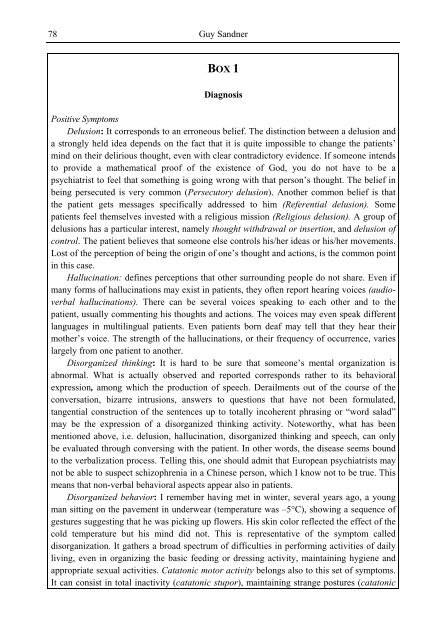Schizophrenia Research Trends
Schizophrenia Research Trends
Schizophrenia Research Trends
- No tags were found...
You also want an ePaper? Increase the reach of your titles
YUMPU automatically turns print PDFs into web optimized ePapers that Google loves.
78Guy SandnerBOX 1DiagnosisPositive SymptomsDelusion: It corresponds to an erroneous belief. The distinction between a delusion anda strongly held idea depends on the fact that it is quite impossible to change the patients’mind on their delirious thought, even with clear contradictory evidence. If someone intendsto provide a mathematical proof of the existence of God, you do not have to be apsychiatrist to feel that something is going wrong with that person’s thought. The belief inbeing persecuted is very common (Persecutory delusion). Another common belief is thatthe patient gets messages specifically addressed to him (Referential delusion). Somepatients feel themselves invested with a religious mission (Religious delusion). A group ofdelusions has a particular interest, namely thought withdrawal or insertion, and delusion ofcontrol. The patient believes that someone else controls his/her ideas or his/her movements.Lost of the perception of being the origin of one’s thought and actions, is the common pointin this case.Hallucination: defines perceptions that other surrounding people do not share. Even ifmany forms of hallucinations may exist in patients, they often report hearing voices (audioverbalhallucinations). There can be several voices speaking to each other and to thepatient, usually commenting his thoughts and actions. The voices may even speak differentlanguages in multilingual patients. Even patients born deaf may tell that they hear theirmother’s voice. The strength of the hallucinations, or their frequency of occurrence, varieslargely from one patient to another.Disorganized thinking: It is hard to be sure that someone’s mental organization isabnormal. What is actually observed and reported corresponds rather to its behavioralexpression, among which the production of speech. Derailments out of the course of theconversation, bizarre intrusions, answers to questions that have not been formulated,tangential construction of the sentences up to totally incoherent phrasing or “word salad”may be the expression of a disorganized thinking activity. Noteworthy, what has beenmentioned above, i.e. delusion, hallucination, disorganized thinking and speech, can onlybe evaluated through conversing with the patient. In other words, the disease seems boundto the verbalization process. Telling this, one should admit that European psychiatrists maynot be able to suspect schizophrenia in a Chinese person, which I know not to be true. Thismeans that non-verbal behavioral aspects appear also in patients.Disorganized behavior: I remember having met in winter, several years ago, a youngman sitting on the pavement in underwear (temperature was –5°C), showing a sequence ofgestures suggesting that he was picking up flowers. His skin color reflected the effect of thecold temperature but his mind did not. This is representative of the symptom calleddisorganization. It gathers a broad spectrum of difficulties in performing activities of dailyliving, even in organizing the basic feeding or dressing activity, maintaining hygiene andappropriate sexual activities. Catatonic motor activity belongs also to this set of symptoms.It can consist in total inactivity (catatonic stupor), maintaining strange postures (catatonic
















